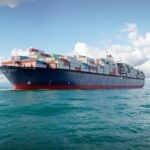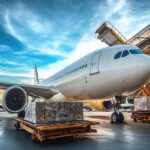- By TOP CHINA FREIGHT
- August 29, 2025
- Shipping
With thousands of factories, complex shipping routes, and strict regulations, businesses rely on freight forwarders in China to simplify operations, cut costs, and ensure smooth delivery. This comprehensive guide explores the role of freight forwarders, types of services, cost structures, and actionable tips for building efficient supply chains — without repeating the content from earlier discussions.

1.Freight Forwarders in China
Freight forwarders in China are more than shipping agents — they are strategic partners who:
- Negotiate competitive freight rates with carriers.
- Streamline documentation to avoid delays.
- Manage end-to-end logistics, from factory to final delivery.
- Offer flexible solutions for businesses of all sizes.
- Provide expertise in navigating Chinese export regulations.
Their expertise helps businesses maintain reliability and profitability in a competitive global market.
2.Types of Freight Forwarders in China
General Freight Forwarders
Best for businesses with consistent shipping needs but without complex requirements.
Specialized Forwarders
Focus on niche industries like electronics, pharmaceuticals, or automotive, offering customized solutions.
Digital Forwarders
Use platforms and AI to automate bookings, tracking, and documentation for tech-savvy clients.
Multimodal Forwarders
Provide integrated sea, air, rail, and trucking solutions for flexibility and speed.
3.Key Transportation Modes
| Mode | Best For | Average Transit Time |
|---|---|---|
| Sea Freight | Bulk shipments, heavy goods | 20–45 days |
| Air Freight | Urgent, high-value items | 3–7 days |
| Rail Freight | Mid-volume, Europe-bound cargo | 15–20 days |
| Courier/Express | Small parcels, e-commerce | 3–5 days |
Forwarders tailor transport modes based on your budget, timeline, and cargo type.
4.Core Services Provided by Freight Forwarders in China
- Customs clearance and regulatory compliance.
- Cargo insurance for damage or loss protection.
- Warehousing and inventory management.
- Last-mile delivery coordination.
- Real-time tracking and shipment visibility.
- Value-added services, such as labeling or repacking.
5.Cost Structure and Pricing Factors
| Cost Driver | Impact on Price |
|---|---|
| Shipment size/weight | Larger loads cost more. |
| Destination region | Remote locations add surcharges. |
| Transport mode | Air is pricier; sea is most economical. |
| Seasonal demand | Rates spike during Q4 and Chinese New Year. |
| Fuel and port fees | Affect overall freight charges. |
| Value-added services | Insurance, warehousing, and documentation increase costs. |
6.Benefits of Using Freight Forwarders in China
- Expert negotiation skills to secure better rates.
- Time savings through professional handling of paperwork.
- Risk reduction with insurance and route planning.
- Access to a vast network of carriers and agents globally.
- Improved supply chain visibility with digital tracking tools.
7.How to Select the Right Freight Forwarder
1.Check licensing and certifications (NVOCC, FIATA).
2.Evaluate global network strength for better coverage.
3.Demand transparent pricing with detailed quotes.
4.Assess digital capabilities like real-time dashboards.
5.Review customer feedback for reliability.
6.Consider scalability to support future growth.
8.Technology Driving Logistics Innovation
- AI-powered forecasting for pricing and routing.
- Blockchain for secure documentation and fraud prevention.
- IoT-enabled sensors for real-time cargo condition monitoring.
- Automated customs filing to reduce errors and speed clearance.
9.Risk Management for Safer Shipping
| Risk | Solution |
|---|---|
| Cargo damage | Use quality packaging and insurance. |
| Port congestion delays | Book early and plan alternative routes. |
| Regulatory changes | Partner with forwarders updated on compliance laws. |
| Lost visibility | Choose providers with real-time tracking tools. |
10.Sustainability and Green Logistics
Forwarders are adopting eco-friendly practices such as:
- Partnering with carriers using low-emission vessels.
- Offering carbon-offset options for shipments.
- Consolidating loads to reduce energy use.
- Promoting recyclable or minimal packaging.
11.Common Mistakes to Avoid
| Mistake | Impact | Prevention |
|---|---|---|
| Incomplete paperwork | Customs delays or fines | Double-check documents |
| Choosing the cheapest option | Poor service or hidden fees | Focus on value, not just price |
| Last-minute bookings | Higher costs, space shortages | Plan ahead, especially in peak seasons |
| Ignoring insurance | Financial loss during disruptions | Always insure cargo |
Conclusion
Partnering with experienced freight forwarders in China is essential for businesses aiming to simplify logistics, lower costs, and maintain reliable delivery schedules. With technology integration, global networks, and expert knowledge, these forwarders help companies of all sizes stay competitive in an evolving trade environment.
Need a Shipping Quote?
If you want expert guidance and peace of mind, our team is ready to assist.
TJ China Freight offers tailored solutions to help businesses of all sizes ship more reliably from China.
FAQs
Q1:Can freight forwarders in China handle small shipments?
Yes, many offer LCL and courier services ideal for startups or low-volume traders.
Q2:How do forwarders manage peak season challenges?
They secure space in advance and may suggest alternative routes to avoid congestion.
Q3:Is real-time tracking available for all shipments?
Most forwarders now provide advanced tracking systems for visibility from pickup to delivery.
Q4:How do I verify if a forwarder is reliable?
Check certifications, online reviews, and request references from past clients.
Q5:Can forwarders help with customs compliance?
Absolutely — they prepare accurate documentation and coordinate with brokers to prevent delays.




